You might not realize that even a small leak can lead to severe long-term damage if not addressed properly. Many people mistakenly believe they're saving money by opting for DIY cleanup methods, but this often overlooks hidden moisture that can cause mold and health issues. Furthermore, not all water damage is treated similarly, and insurance coverage can be more complicated than you think. Understanding the myths surrounding water damage restoration is vital for protecting your home and health, and the truth might surprise you.
Water Damage Is Only a Minor Issue
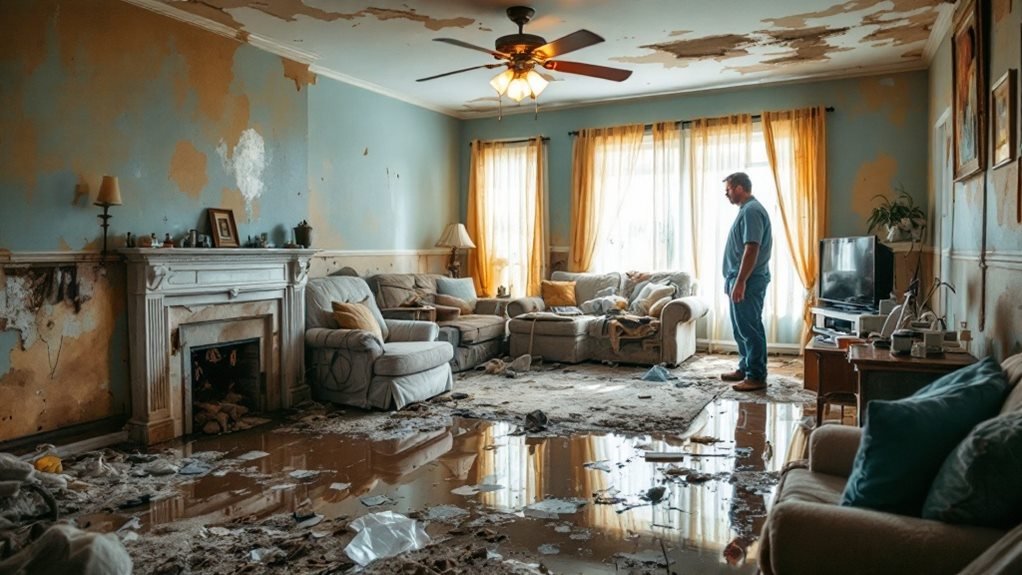
Many homeowners mistakenly believe that water damage is merely a minor issue that can be easily managed. You might think a little leak is just a tiny inconvenience, but let's face it—ignoring it is like pretending your dog didn't eat your assignment; it won't end well. Water misconceptions often lead you to underestimate the potential havoc a seemingly minor damage can wreak.
Sure, a few drops here and there might not seem catastrophic, but water can be an insidious intruder. It seeps into walls, floors, and even your beloved collection of vintage comic books. You know, the ones you thought you could just dry off with a towel? Spoiler alert: that doesn't work.
Over time, what starts as minor damage can escalate into mold infestations, structural instability, or even health risks for you and your family. So, before you toss that wet sponge aside like yesterday's leftovers, consider the bigger picture. Water is sneaky, and it doesn't play by your rules. It's better to address water issues head-on than to find yourself knee-deep in a more significant problem later!
DIY Cleanup Is Always Effective
You might think that DIY cleanup after water damage is sufficient, but improper techniques can lead to serious risks. Hidden water damage issues often lurk beneath surfaces, leading to mold growth and structural problems that you can't see. Plus, professional restoration teams use specialized tools that guarantee a thorough and effective cleanup, something standard household equipment simply can't match.
Risks of Improper Cleanup
Improper cleanup after water damage can lead to significant long-term issues, making the belief that DIY methods are always effective a dangerous myth. You might think you can handle it yourself, but the risks are real. Ignoring professional help could compromise your home's structural integrity and create a mold fiesta that no one wants to attend.
Here are five risks you might not have considered:
- Mold Growth: Without proper mold remediation, you could be growing a science project in the corners of your home.
- Structural Damage: Water can weaken walls and ceilings—think of your home as a house of cards, but with more sogginess.
- Health Hazards: Hidden mold and contaminants can lead to respiratory issues or allergic reactions. Fun, right?
- Increased Costs: What starts as a small DIY fix can snowball into a costly disaster. You might end up paying for a pro anyway!
- Time Consumption: DIY cleanup often takes longer than anticipated. Who knew drying out your basement could become a full-time job?
Hidden Water Damage Issues
Even when the visible signs of water damage seem to be addressed, hidden issues can linger long after the DIY cleanup appears successful. You might think you've conquered that pesky leak, but those sneaky moisture pockets could be throwing a party behind your walls. Trust me, you don't want to crash that shindig!
Leak detection isn't just for detectives with magnifying glasses; it's an essential step to uncovering the hidden damage. If you miss a small leak, it can lead to mold growth and structural issues down the line. Moisture mapping is another tool that can be a transformative factor. Using thermal imaging or moisture meters, it helps pinpoint those areas that are still damp, even though they look dry on the surface.
Professional Tools Matter
Many homeowners underestimate the importance of professional tools in water damage restoration, believing that DIY cleanup methods are always sufficient. While your trusty mop and bucket might seem like a superhero team, they lack the advanced equipment and restoration technology needed to tackle serious water damage effectively.
Here's why relying solely on DIY can leave you high and dry:
- Hidden Moisture: DIY methods often miss water lurking in walls or under floors.
- Ineffective Drying: A fan can't compete with industrial-grade dehumidifiers that suck moisture out like a vacuum on steroids.
- Contamination Risks: Without proper gear, you might spread mold and bacteria, turning your home into a science experiment.
- Structural Damage: Inadequate tools can lead to bigger issues, like warped wood or weakened foundations.
- Time Sink: You'll waste hours on ineffective methods when professionals can get it done right—fast!
All Water Damage Is the Same
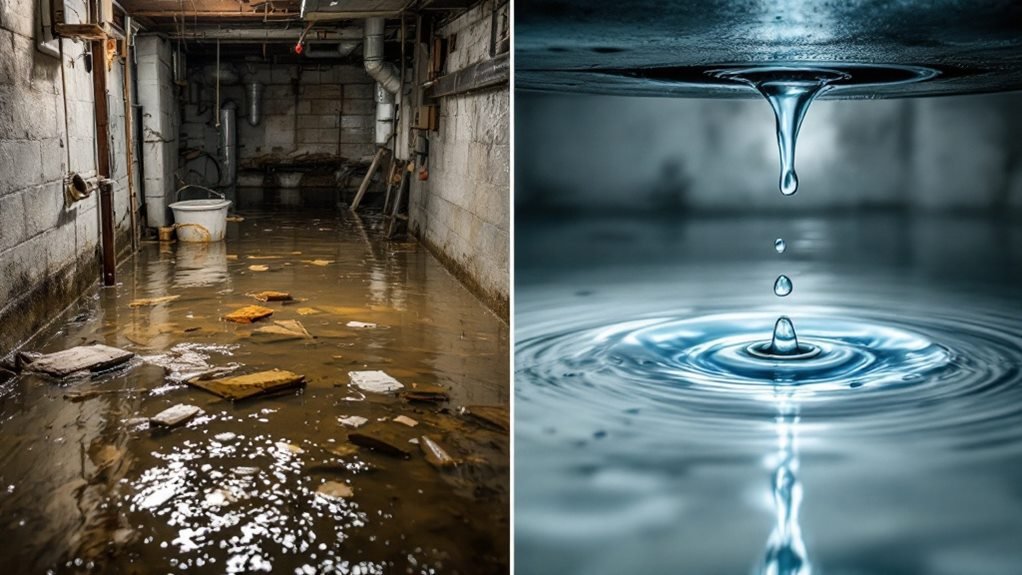
Not all water damage is equal; it varies greatly based on the source and its contaminants. Understanding these differences is essential since they impact the restoration process and the long-term effects on your property. By recognizing the specific type of water damage, you can guarantee a more effective and tailored restoration approach.
Types of Water Damage
Understanding the various types of water damage is crucial for effective restoration, as not all water damage is created equal. You wouldn't treat a simple roof leak the same way you'd handle a full-blown flood, right? Here's a quick breakdown of common types of water damage you might encounter:
- Flood Damage: Your backyard turned swimming pool thanks to Mother Nature.
- Sewage Backup: When plumbing failures take a turn for the gross—yikes!
- Appliance Leaks: Those pesky leaks from your washing machine that turn your laundry room into a water park.
- Storm Damage: Wind and rain don't just ruin your plans; they can cause serious harm to your home.
- Basement Flooding: Groundwater intrusion or burst pipes can transform your basement into an unwelcome aquarium.
Each type of water damage requires a unique approach to restoration. So, while it may be tempting to think of them all as one big wet mess, they each come with their own set of challenges. Understanding these distinctions can save you time, money, and a whole lot of headaches down the line!
Impact on Restoration Process
When dealing with water damage, it's vital to recognize that not all situations are the same, as this misconception can severely impact the restoration process. You might think a little leak is just a minor inconvenience, but it could lead to mold growth faster than you can say "where's my bucket?" Each type of water damage—clean, gray, or black—requires specific drying techniques and approaches.
Ignoring this distinction might just turn your restoration timeline from a speedy few days into a torturous week or more. For instance, clean water damage might take less time to fix, while black water will have you wishing you'd never left the lid up.
A tailored restoration plan isn't just a fancy way of saying "we know what we're doing"; it's fundamental for preventing further damage and getting your space back to normal. So, next time water decides to crash your party, remember that understanding the type of damage can save you time, money, and possibly a few tears. Don't let misconceptions drown your restoration efforts—be informed, be prepared, and you'll be back on dry land in no time!
Long-Term Effects Vary
How can you believe all water damage is the same? Spoiler alert: it's not! The long-term effects of water damage can vary dramatically based on the source of the water, how quickly you act, and the materials involved. Don't let anyone tell you otherwise; your restoration timelines depend on these factors.
Here are five key points to reflect on:
- Source Matters: Clean water from a broken pipe is different from murky floodwater.
- Material Impact: Wood, drywall, and carpet all respond differently to moisture.
- Time Is of the Essence: The longer you wait, the worse it gets—seriously, don't test this!
- Mold's Sneaky Nature: It can start growing within 24 hours, making your life a whole lot messier.
- Future Risks: Neglected damage can lead to structural issues or health problems down the line.
Insurance Covers All Water Damage
Many homeowners mistakenly believe that insurance covers all types of water damage, leading to unexpected financial burdens later on. Unfortunately, this myth can leave you high and dry—literally. Most insurance policies come with coverage limitations and policy exclusions that can surprise even the savviest homeowner. For instance, while your policy might cover sudden incidents like a burst pipe, it probably won't cover damage from long-term leaks or negligence.
If you think your insurance will bail you out for that flooded basement caused by your overzealous DIY plumbing attempts, think again! Many policies exclude damages from maintenance issues or neglect, leaving you holding the bill when the waterworks turn into water woes.
To avoid being caught off guard, always read your policy in detail. If you're unsure, ask your agent for clarification. They might not have a magic wand, but they can guide you through the murky waters of your coverage. Remember, understanding your insurance can help you navigate the storm before it hits. So, don't let the myth of full coverage drown your wallet—be informed, be proactive, and keep those financial lifeboats ready!
Mold Will Not Grow If Dried Quickly
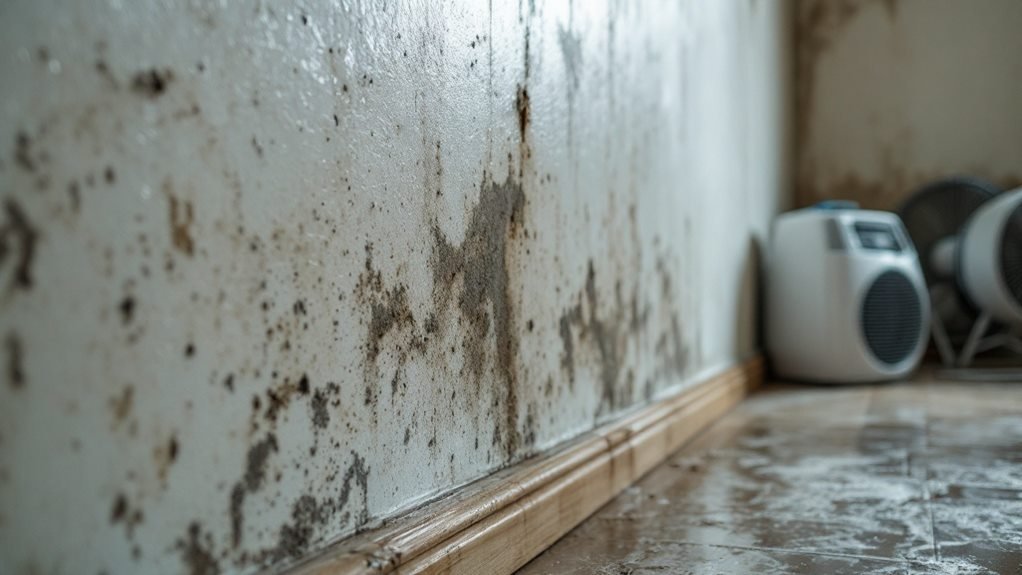
Here are a few vital points to reflect on:
- Mold loves dampness: If humidity levels remain high, even after drying, mold can still thrive.
- Hidden moisture: You might think you've dried everything, but water can hide in walls or under flooring.
- Time is essential: Mold can start growing within 24-48 hours if conditions are right.
- Temperature matters: Warm, humid environments are mold's favorite party spots.
- Inadequate drying techniques: Using fans isn't always enough; you may need dehumidifiers or specialized equipment.
Professional Services Are Unnecessary
You might think you can handle water damage on your own, but ignoring professional services can lead to serious health risks and hidden damage that's hard to detect. These experts not only save you time but additionally help you avoid costly repairs down the line. Don't underestimate the value of professional help in ensuring a thorough and effective restoration.
Health Risks Ignored
Ignoring the potential health risks associated with water damage can lead to serious consequences. Sure, you might think you can handle it yourself, but mold exposure and poor water quality can sneak up on you like a cat in the night—quiet but deadly. Here are some health risks you might be ignoring:
- Respiratory issues: Breathing in mold spores can make you feel like you've got a permanent cold.
- Allergic reactions: Sneezing, itching, and watery eyes are just the beginning; who needs that?
- Skin irritation: Moist environments can lead to rashes that'll have you scratching like a dog with fleas.
- Infections: Water damage can breed bacteria, and nobody wants to end up in a hospital gown.
- Long-term health effects: Chronic exposure to mold can turn your life into an episode of "House" before you know it.
Hidden Damage Potential
Even after addressing the health risks of water damage, the dangers can linger beneath the surface, often going unnoticed. You might think a little water here and there won't hurt, but hidden damage can spring up like a bad magic trick. Without proper hidden leak detection, those sneaky leaks can cause structural issues and mold growth that'll make your house feel like a horror movie set.
Professional services aren't just for the faint of heart. They bring tools like moisture mapping to the party, revealing moisture levels in materials you didn't even know were thirsty. It's like having a moisture detective on your team, searching for clues in your walls, floors, and ceilings. You might feel tempted to DIY it, but you could be playing a risky game of hide and seek with mold and decay.
Time and Cost Savings
Many homeowners believe that handling water damage restoration on their own will save both time and money. While it might sound like a great idea, skipping professional services can actually lead to more headaches and expenses down the line. You might think you're achieving time efficiency and cost reduction, but let's break down the reality:
- Mold Growth: It only takes 24-48 hours for mold to start its party, and it's not the fun kind.
- Hidden Damage: You might miss out on damage behind walls, costing you more later.
- Inefficient Equipment: Renting equipment can be a hassle and may not work as effectively as professional-grade gear.
- Time Consumption: DIY can take longer than you think—think of it as a time-sucking black hole.
- Insurance Issues: A botched DIY job could void your insurance claim, leading to a financial disaster.
In the end, hiring professionals guarantees that you get the job done right, saving you precious time and money. So, before you channel your inner handyman, consider the long-term savings of letting the pros handle it!
Bleach Is the Best Disinfectant
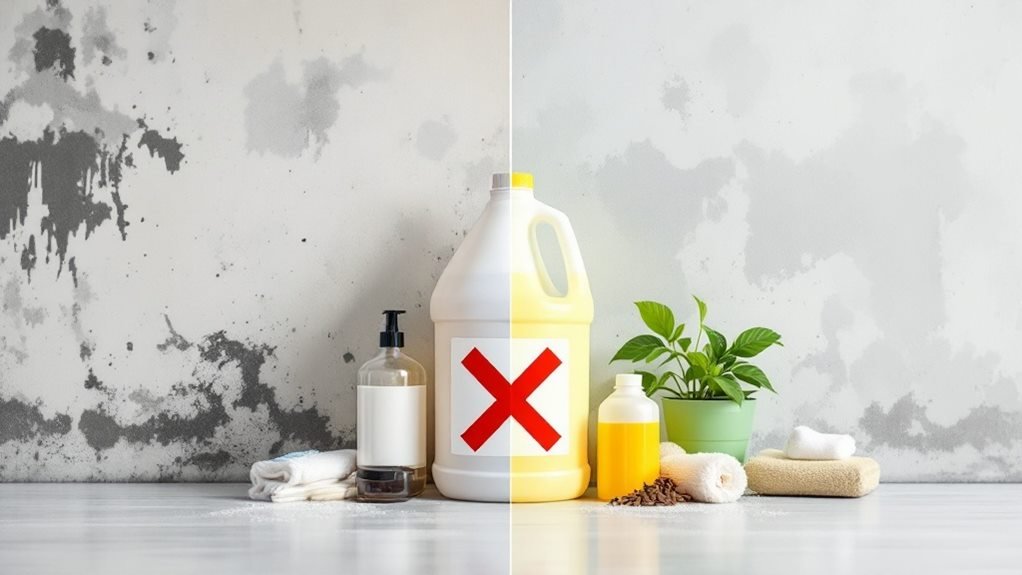
While bleach is often touted as the go-to disinfectant for water damage restoration, it's crucial to understand its limitations. Sure, it can kill bacteria and mold, but don't let that blind you to the potential bleach safety concerns. You might be surprised to learn there are effective disinfectant alternatives that can do the job without the harsh side effects.
Here's a quick comparison to help you see the bigger picture:
| Disinfectant | Effectiveness | Safety Concerns |
|---|---|---|
| Bleach | High | Skin irritation, fumes |
| Hydrogen Peroxide | Moderate | Can bleach fabrics |
| Vinegar | Low | Smell and acidity |
| Rubbing Alcohol | High | Flammable, can dry skin |
| Vital Oils | Low to Moderate | Allergies in some individuals |
You Can Wait to Address Water Damage
Ignoring water damage may seem like a minor issue at first, but delaying action can lead to severe consequences. You might think you can wait it out, but trust me, your future self will not thank you for that decision. An immediate response is essential to prevent escalating problems that could cost you more than just money. Here's what you might face if you let water damage sit:
- Mold Growth: That lovely little fungus can start partying within 24 hours.
- Structural Damage: Your home isn't a sponge; it can weaken and warp over time.
- Increased Repair Costs: Procrastination isn't cheap—your wallet will feel the pinch.
- Health Risks: Hidden moisture can lead to respiratory issues and other health problems.
- Decreased Property Value: Don't let water damage be the reason your home's value takes a plunge.
Homeowners Can Handle All Repairs
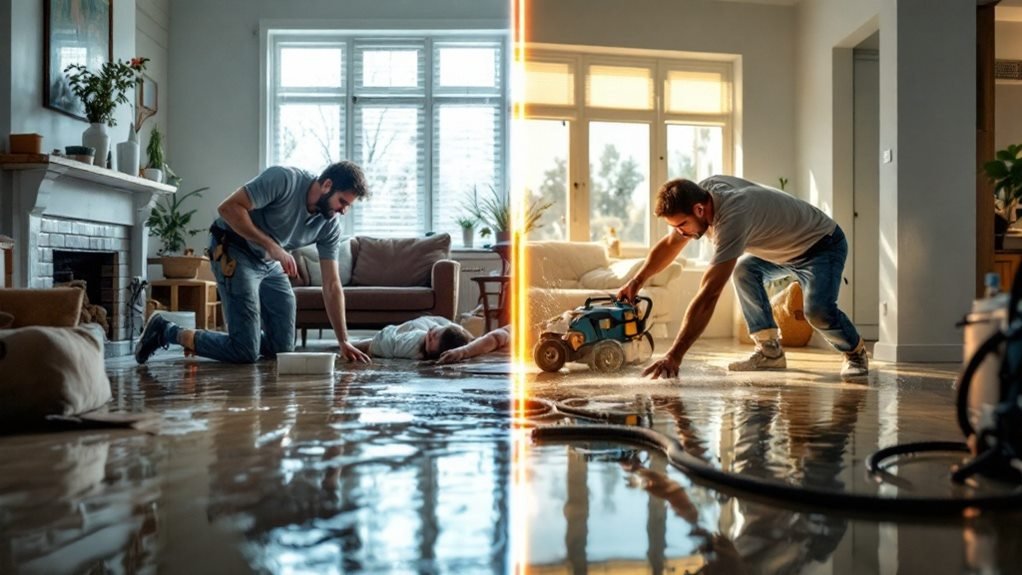
Not every homeowner is equipped to handle all water damage repairs on their own. While DIY might be your go-to for minor fixes, water damage often needs more than just a plunger and good intentions. You may have some repair limitations that could turn a simple leak into a full-blown disaster.
| Homeowner Preparedness | Professional Skills |
|---|---|
| Basic plumbing knowledge | Advanced moisture detection |
| DIY repair experience | Structural integrity assessment |
| Paint and patch skills | Mold remediation expertise |
You might think, "I've got this!" but tackling complex repairs without proper training can lead to bigger issues down the line—like mold, structural damage, or a DIY horror story worthy of a sitcom. Professionals not only bring the right tools but likewise know the ins and outs of water damage restoration. Plus, if you're trying to impress your neighbors, a botched repair isn't the way to go! So, don't just grab a toolbox; consider the value of calling in the experts when the water starts rising. Your home—and your sanity—will thank you!
Water Damage Odors Will Just Disappear
Water damage odors won't just vanish on their own; they often linger long after the visible signs of moisture are gone. If you think those funky smells will magically disappear, think again! Ignoring them can lead to long-term odor effects that'll make your home feel like a musty dungeon.
Here's what you need to know about effective odor removal techniques:
- Identify the Source: Don't just cover up the smell; find out where it's coming from.
- Thorough Cleaning: Use proper cleaning agents to tackle mold and mildew.
- Dry Everything Out: Moisture promotes odors, so make sure everything is completely dried.
- Use Deodorizers: Apply professional-grade odor neutralizers, not just air fresheners.
- Consider Professional Help: Sometimes, a pro's touch is necessary to get it all sorted.
Frequently Asked Questions
How Can I Prevent Water Damage in My Home?
To prevent water damage in your home, make sure your drainage systems work properly and schedule regular plumbing maintenance. Trust me, ignoring leaks is like inviting a flood—don't let water crash your party!
What Are the Long-Term Effects of Untreated Water Damage?
If you leave water damage untreated, you'll face mold growth and compromised structural integrity. Both can turn your home into a science experiment, and trust me, that's one experiment you don't want to participate in!
Is All Mold Harmful After Water Damage?
Not all mold types are harmful, but you can't just guess. Proper mold identification is essential. Some molds are just freeloaders, while others might throw a party that could affect your health. Stay informed!
How Quickly Should I Act After a Leak?
You've just found a leak—don't panic! Act fast; leak detection and emergency response are vital. Within 24-48 hours, you'll minimize damage and keep your home dry. Remember, procrastination doesn't fix plumbing issues!
Can Water Damage Affect My Home's Resale Value?
Yes, water damage can negatively impact your home's resale value. Buyers often perceive properties with past issues as risky investments, leading to lower offers. Addressing any damage promptly can help maintain your property's appeal and worth.
Conclusion
To sum up, ignoring water damage is like inviting a tornado into your living room—disastrous and wholly preventable. Don't let myths lull you into a false sense of security; your home deserves better. Relying on DIY methods or believing that minor leaks are harmless is a recipe for catastrophe. Trust professional restoration services to tackle this menace head-on, ensuring your property remains a safe haven. Act swiftly; the longer you wait, the greater the risk to your health and home.

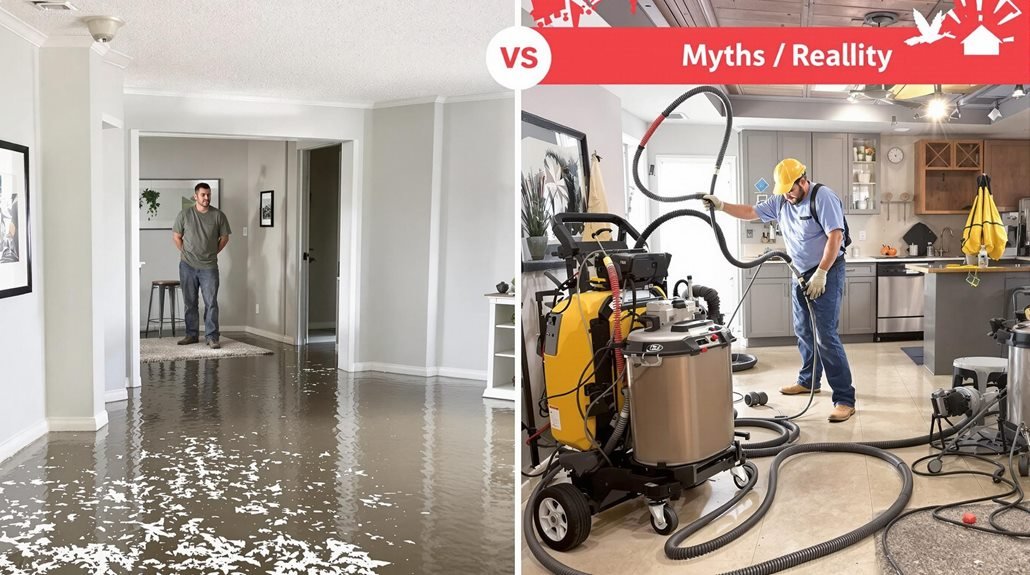
Recent Comments